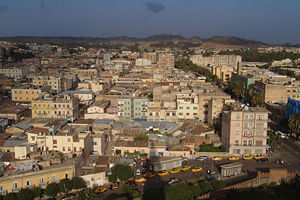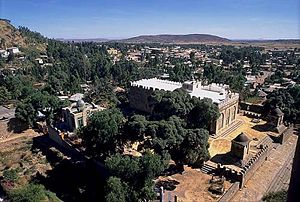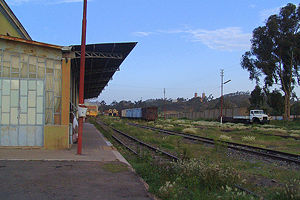Asmara
| Asmara ኣስመራ Asmera, أسمرا Asmara |
|
 |
|
 Asmara
|
|
| Coordinates: | |
| Country | Eritrea |
|---|---|
| Elevation | 7,628 ft (2,325 m) |
| Population (2003) | |
| - Total | 400,000 |
| - Density | 85.2/sq mi (32.9/km²) |
| Time zone | EAT (UTC+3) |
Asmara (English) (Ge'ez: ኣስመራ Asmera, formerly known as Asmera, or in Arabic: أسمرا Asmara) is the capital city and largest settlement in Eritrea, home to a population of around 579,000 people. At an elevation of 2,400 meters (7 874 ft), Asmara is on the edge of an escarpment that is both the northwestern edge of the Great Rift Valley and of the Eritrean highlands. Textiles and clothing, processed meat, beer, shoes, and ceramics are the major industrial products. Asmara started with four villages, to being a regional center under Emperor Yohannes IV of Ethiopia, to "Little Rome" of Mussolini's unsuccessful second Roman Empire, to being a provincial capital under Emperor Haile Selassie I of Ethiopia and lastly a national capital of Eritrea.
Contents |
History
Asmara was born out of a union of four villages that took place during the twelfth century. Originally, it is said, there were four clans living in the Asmara area on the Kebessa Plateau: Gheza Gurtom, Gheza Shelele, Gheza Serenser and Gheza Asmae. Encouraged by their women, the men united the four clans and defeated the bandits who preyed on the area. After the victory, a new name was given to the place, Arbaete Asmera which literally means, in the Tigrinya language, the four (female plural) united. Eventually Arbaete was dropped and it has been called Asmera, though there is still a zone called Arbaete Asmera.



The missionary Remedius Prutky passed through Asmara in 1751, and described in his memoirs that a church built there by Jesuit priests 130 years before was still intact.[1]
Asmara acquired importance in 1881, when Ras Alula Engida whom Emperor Yohannes IV of Ethiopia had appointed governor of the region founded a market in that place. A few years later, in 1884, he moved his capital from Adi Taklay to Asmara and had three stone buildings built to house his troops and serve as his banquet hall. About the same time Ras Alula ordered all of the other markets in the Mareb Mellash province closed (which included Sazega and Kudofelasi in modern Eritrea as well as Idaga Hamus in Ethiopia), giving further economic stimulus to Asmara. The population grew from an estimated 150 people in 1830 to 2,000 during Alula's governorship.[2]
Asmara was occupied by Italy in 1889 and became the national capital in 1897. In the early 20th century, a railway line was built to the coast, passing through the town of Ghinda, under the direction of Carlo Cavanna. In both 1913 and 1915 the city suffered only slight damage in large earthquakes.[3] In the late 1930s the Italians changed the face of the town, with a new structure and new buildings; Asmara was called Piccola Roma (Little Rome). While Eritrea was under Italian colonial rule, architecturally conservative early-20th-century Europeans used Asmara "to experiment with radical new designs."[4] Nowadays the major part of buildings are of Italian origin, and shops still have Italian names (e.g. Bar Vittoria, Pasticceria moderna, Casa del formaggio, and Ferramenta).
Asmara was populated by a numerous Italian community and consequently the city acquired an Italian architectural look. The city of Asmara had a population of 98,000, of which 53,000 were Italian Eritreans according to the Italian census of 1939. This fact made Asmara the main "Italian town" of the Italian empire in Africa.In all Eritrea the Italians were 75,000 in that year.[1]
Many industrial investments were done by the Kingdom of Italy in Asmara, but the beginning of World War II stopped the blossoming industrialization of the area.
During the Eritrean war for independence from Ethiopia, Asmara's airport became a key in the conflict, as it was used by the Ethiopians to obtain arms and supplies from outside supporters. The last town to fall to the Eritrean People's Liberation Front in the Eritrean War of Independence, it was besieged in 1990 and was surrendered by Military of Ethiopia troops without a fight on May 24, 1991.
In Asmara the main language is Tigrinya. Italian and English are widely spoken and understood.[5]
Features

The city is home to the Eritrean National Museum and is known for its early twentieth century buildings, including the Art Deco Cinema Impero, Cubist Africa Pension, eclectic Orthodox Cathedral and former Opera House, the futurist Fiat Tagliero Building, neo-Romanesque Roman Catholic Cathedral, and the neoclassical Governor's Palace. The city is littered with Italian colonial villas and mansions. Most of central Asmara was built between 1935 and 1941, so effectively the Italians managed to build almost an entire city, in just six short years.[6] At this time, the dictator Mussolini had great plans for a second Roman Empire in Africa. War cut this short however, but his injection of funds adversely made Asmara what it is today, and was supposedly a symbol that Fascism was working and an ideal system of government.
The city shows off most early 20th century architectural styles; some buildings are neo-Romanesque, such as the Roman Catholic Cathedral, some villas are built in a late Victorian style. Art Deco influences are found throughout the city; essentially Asmara was then what Dubai is now. Architects were restricted by nothing more than the bounds of their imaginations and were given the funds to create masterpieces which we can see today. Essences of Cubism can be found on the Africa Pension Building, and on a small collection of buildings. The Fiat Tagliero Building shows almost the height of futurism, just as it was coming into big fashion in Italy. In recent times, some buildings have been functionally built which sometimes can spoil the atmosphere of some cities, but they fit into Asmara as it is such a modern city.
Asmara is also home to the University of Asmara and a nineteenth century fort, Forte Baldissera. It is served by Asmara International Airport, and is connected to the port of Massawa by the Eritrean Railway.
Asmara is also the see of the archbishop of the Eritrean Orthodox Church, which became autocephalous in 1993. The archbishop was elevated in 1998 to the rank of Patriarchate of Eritrea, on a par with the Ethiopian Orthodox Tewahedo Church.


Asmara was known to be an exceptionally modern city, not only because of its architecture, but Asmara also had more traffic lights than Rome did when the city was being built. [6] The city incorporates many features of a planned city. Indeed, Asmara was an early example of an ideal modern city created by architects, an idea which was introduced into many cities across the world, such as Brasilia, but which was not altogether popular. Features include designated city zoning and planning, wide treed boulevards, political areas and districts and space and scope for development. Asmara was not built for the Eritreans however; the Italians built it primarily for themselves. One unfortunate aspect of the city's planning was areas designated for Italians, and Eritreans, each disproportionately sized.
The city has been regarded as New Rome or Italy's African City due to its quintessential Italian touch, not only for the architecture, but also for the wide streets, piazzas and coffee bars. There are numerable pizzerias and coffee bars, serving cappucinos and lattes, as well as ice cream parlours. The people in Asmara dress in a unique, yet African style. Asmara is also highly praised for its peaceful, crime-free environment. It is one of the cleanest cities of Africa.
The city hosts the We Are the Future center, a child care center giving children a chance to live their childhoods and develop a sense of hope. The center is managed under the direction of the mayor’s office, and the international NGO Glocal Forum serves as the fundraiser and program planner and coordinator for the WAF child center in each city. Each WAF city is linked to several peer cities and public and private partners to create a unique international coalition. Launched in 2004, the program is the result of a strategic partnership between the Glocal Forum, the Quincy Jones Listen Up Foundation and Mr. Hani Masri, with the support of the World Bank, UN agencies and major companies.
Asmara has been proposed as a possible new addition to the UNESCO World Heritage Sites[6], under the direction of the Cultural Assets Rehabilitation Project, for its outstanding examples of 20th century architecture and town planning. Many of these historic buildings are not currently being taken care of and there is a serious risk that this heritage could be lost.
The Historic Center of Asmara was placed on the World Monuments Fund's 2006 Watch List of 100 Most Endangered Sites. The listing was designed to bring more attention to the city to save the center from decay and redevelopment and to promote restoration.

References
- ↑ J.H. Arrowsmith-Brown, translator and editor, Prutky's Travels to Ethiopia and Other Countries (London: Hakluyt Society, 1991), p. 78.
- ↑ Erlich, Haggai (1996). Ras Alula and the Scramble for Africa. Lawrenceville: Red Sea. ISBN 1-56902-029-9.
- ↑ Ambrayses, Nicholas; Melville, C.P., Adams, R.D. (1994). The Seismicity of Egypt, Arabia and the Red Sea: A Historical Review. Cambridge University Press. ISBN 0-521-39120-2.
- ↑ Asmara useful for experimenting with radical designs for Europeans
- ↑ "Languages in Eritrea". Retrieved on 2006-07-18.
- ↑ 6.0 6.1 6.2 "Reviving Asmara", BBC 3 Radio (2005-06-19). Retrieved on 2006-08-30.
Further reading
- Edward Denison, Guang Yu Ren, Naigzy Gebremedhin, and Guang Yu Ren, Asmara: Africa's Secret Modernist City (2003) ISBN 1-85894-209-8
See also
- Eritrea
- Italian Eritreans
External links
- History of Asmara An excellent website about the city
- HolmeInAfrica Two VSO volunteers spend a year living in Asmara, Eritrea
- JustinHillAuthor.com Ciao Asmara, VSO volunteer Justin Hill's book
- Eritrea In Pictures Hundreds of pictures of Art Deco and Moderne Asmara, with some of its most and least famous beautiful buildings on
- Ferrovia eritrea Eritrean Railway
- Eritrea About Eritrea
- Postcards and pictures of Italian Asmara
|
||||||||